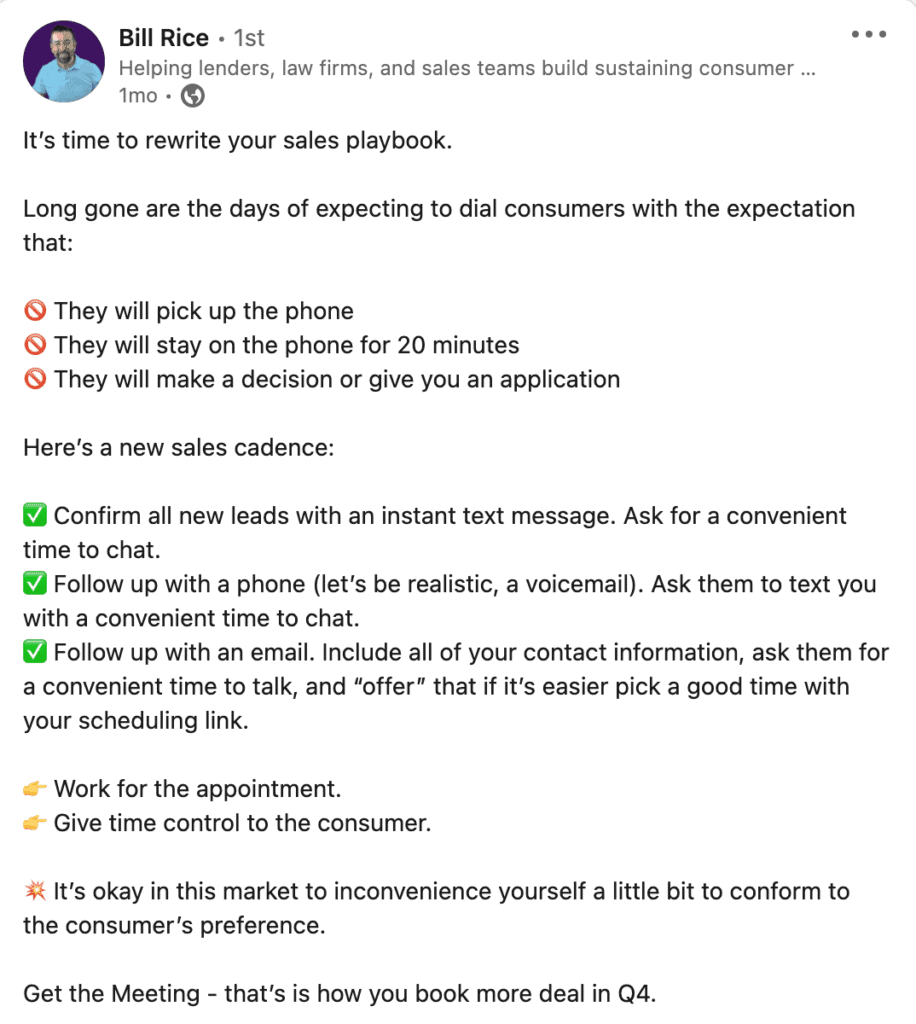Do you have unique industry insights and experiences to share? Do you dream of having true influence in your industry and making an impact on those around you? These aspirations are the definition of a thought leader.
Thought leadership pays off in a digital marketing strategy: According to Semrush, 81% of thought leadership content results in organic traffic, and 48% generates actual leads and sales.
In other words, thought leadership content has the potential to perform better than average content.
The good news is that anyone can be a thought leader in 2023. But that’s also the not-so-good news.
It takes a lot of time and effort to become not only a trusted expert but someone others look to as a positive, reliable force in an industry.
In 2023, it’s even more difficult to stand out from others and to have a voice among the thousands of other pages and profiles.
However, it can be done. With patience, persistence, hard work, and a willingness to continue listening and learning, you can build yourself as a true thought leader in your industry.
Let’s get started.
Skip ahead: Schedule your free 2023 strategy session with Kaleidico
How to become a thought leader in your niche
Thought leadership is a major incoming trend for 2023 that’s even Google algorithm-approved.
Instead of continuing to churn out content that competes with others for keywords or the No. 1 search spot, thought leadership content is in a league of its own.
It goes above informing the reader or answering a question and instead aims to inspire and entertain from the unique perspective of an industry expert.
The secret to becoming a thought leader is to establish a niche area of your industry to focus on.
So, what is your niche?
As a business owner, you most likely know a lot about your industry, in a lot of different areas.
But what are you most passionate about? What do you find yourself reading about the most, or who are the types of leaders you follow on your social media channels? What are you good at?
Let’s take a look at how to become a thought leader in your niche.
Set aside your agenda
There’s a powerful brand behind every powerful thought leader, but the “agenda” or focus should first be to understand the niche audience and offer solutions and information based on the issues that affect this niche.
If you focus solely on sales, your audience will see right through this.
Your influence as a thought leader will naturally affect your sales over time, but the goal is not immediate sales — the goal is to cultivate ideas and solutions that help your audience.
Bulk up your online presence

Becoming a thought leader means you need to be visible to others.
Where is your audience hanging out? Where are other industry leaders posting?
Make a list of where you need to be posting content, which might include:
- TikTok
- Other industry-specific forums
You don’t need to be posting on every single platform unless you have the time and energy to do so, but pick a few and make sure you do have the time and energy to be present and active on those.
Post consistently on all channels
In general, the more frequently you post, the more followers and engagement you’ll earn. However, posting 20 times per day probably isn’t the answer, either.
To begin, just start creating. You can then focus on developing a posting schedule that works for you.
If you’re looking for your sweet spot, keep a spreadsheet of each social media channel, the number of times you post per week, and the number of followers you gain.
You also can track your level of engagement per post and per type of post.
Does it matter what time of day you post on social media?
This is a popular question that some people follow religiously and some people don’t bother paying attention to.
But according to the American Marketing Association, the best time to post is generally in the early morning on weekdays.
The “universal” worst day is Saturday.
Here’s a quick rundown from Hootsuite on the “ideal” number of posts to make per day or week on four popular social media channels:
- LinkedIn: 1-5 times per day
- Instagram: 3-7 times per week
- Facebook: 1-2 times per day
- Twitter: 1-5 tweets per day
Of course, you’ll have to measure and determine your own results as you start posting, but you can use that as a starting point and adjust as needed.
You also can automate your posts by scheduling them ahead of time.
Craft thoughtful, informative content that showcases your skills
If you’re aiming for thought leadership, you most likely have a lot of research and insights on your niche topic — meaning you’ll have no shortage of content ideas.
This will help you because you’ll need to consistently create and post content to all your channels so you remain a reliable and relevant source of information.
As far as types of content, you’ll want to pick mediums you excel in but also showcase that you’re a well-rounded professional by branching out when possible.
Types of thought leadership content includes:
- Articles or blogs
- Educational videos
- Infographics
- Photos
- Case studies
- Podcasts
- Ebooks
- Newsletters
In addition to your own content, you’ll also need to produce guest content and collaborate with other industry leaders and publications.
This includes proposing your topics and content to publishers or other industry leaders for print and digital publications and reaching out to be a guest on industry-specific podcasts or radio and TV shows.
Make yourself as visible as possible in your industry so your audience can find you.
Through consistent sharing of your thoughtful, quality content, you’ll build an audience that looks forward to your insights and references you as a leader in the industry.
Schedule a free session with Kaleidico and let’s discuss your content strategy.
Choose quality over quantity when posting and selecting topics
Quality over quantity applies to a couple of different aspects of a thought leadership strategy.
First, focus only on the followers who are relevant to your niche and are most likely to stay up-to-date with your content. You don’t need to attract every type of person on the web — just the people who will find the most value in what you have to say.
Remember that when you focus on attracting your niche, these people also have the potential to become customers.
Identify who is in your niche audience by creating customer personas that identify the demographics, behaviors, values, and pain points of these groups of people.
Your content will be tailored to these personas.
Second, don’t post content for the sake of posting.
Your content must be thoughtful, valuable, relevant, and useful, and your insights and opinions have to be backed by real results.
Let’s break down the types of quality content you can create to attract your niche audience.
Blog posts
Your personal blog is your opportunity to go into detail on any number of topics, including:
- Explaining a case study you just released
- Addressing your most frequently asked questions on your social media pages
- Interpreting the latest industry news
- Exploring new industry research and explaining what it means to your audience
- Collaborating with other industry experts or customers
- Breaking down complex topics if your target audience is the average consumer
- Going in-depth on topics if your target audience includes other industry experts
Plan your content topics according to your audience. If you’re a lawyer and your target audience is other lawyers, you would present your information much differently than if you were targeting the average consumer seeking your services.
Keep in mind that optimizing your content for the web and your social media channels can be another full-time job. You don’t have to be the one to create all your content yourself.
You can hire a copywriter, marketing team, or agency to execute your ideas for you.
Videos
Video content is extremely popular right now.
The medium grew exponentially during the COVID-19 pandemic out of necessity but has stuck around due to its accessibility, ease of use, entertainment value, and educational value.
According to Insivia, viewers retain 95% of a message from a video and only 10% from text.
And 60% of website users would rather watch a video if it’s available than read text.
If you enjoy being on camera and feel confident and comfortable explaining your insights and ideas via video, start creating videos and just keep creating!
If you’re not quite there yet, keep practicing. Video isn’t going anywhere, so it would be wise to use this trend to the best of your ability.
You can embed videos into your blog posts to go more in-depth on a topic you mention within the blog, put them in emails or newsletters, and post them frequently on your social media pages.
Take a look at the types of video content your competitors are creating and the types of content your audience loves. Then, do it better!
Infographics and photos
Visual content is easily shareable on social media, so if there are ways you can craft your content into an easily digestible graphic or share it with an interesting, high-quality photo, this will help boost engagement.
Case studies and eBooks
Case studies and eBooks allow you to go in greater depth on certain topics and flex your research and analysis skills.
This content can also be repurposed into multiple blog posts, videos, and infographics to make the ideas bite-sized and easy to share.
Newsletters
I was recently reading a blog post on why newsletters were dying. The writer made some fair points and some arguable points. But at the bottom of the post, there was a box to sign up for a newsletter.
Newsletters might not make sense in some cases, but if you know your audience and what they like, why not send out a post every week or every other week?
You can use your newsletter to inform the audience about new projects you have in the works, new insights on recent news or hot topics, or simply as another way to connect intimately with your audience — straight in their inbox.
Podcasts
A few quick stats on podcast popularity:
- More than 104 million Americans listen to podcasts regularly
- 38% of people 12 and up in the U.S. are monthly podcast listeners
With that many people listening to podcasts, you’re sure to be able to tap into your niche.
Challenge the norm
Part of the role of a thought leader is to offer educated thoughts and opinions.
Occasionally your opinions may be “controversial,” but not in an upsetting way — just in a way that gets people to think about a topic differently.
Thought leaders often have unique opinions and think outside of the box, which is why their audience gravitates toward their new ways of thinking.
For example, if you want to be a thought leader in the mortgage industry and have studied industry trends and statistics your entire career, you might have some helpful insights on the current market and advice on how consumers should proceed in 2023.
These insights may go against how other industry experts or the media are portraying the situation, but it also will be refreshing to your audience to hear your unique perspective.
Schedule your strategy session with Kaleidico.
Stay informed and up-to-date
As a thought leader, your work is never complete. There will always be new research, insights, and voices in your industry.
Follow the latest trends so you can perform your own research and pull together your thoughts and opinions on the news. When big news breaks, consumers look to their most trusted thought leaders for guidance.
Additionally, thought leaders use industry news and breakthroughs to improve their products and services.
Ultimately, it all goes back to your audience: Continue to learn about their challenges, questions, and motivations year after year. Expect your audience to be changing as much as the industry, and stay curious about their experiences.
Use your social media channels to engage with the audience, and keep in close contact with your sales and marketing teams.
Collaborate with other industry peers
Thought leaders are open to the ideas of others and participate in frequent collaborations.
They exude authenticity and aren’t worried about knowing it all — they understand that they don’t know everything, but are eager to learn more from their peers.
Consumers today are more sensitive than ever to authenticity, and they can tell when someone’s focus is just to sell themselves or their product.
In fact, one of the biggest marketing trends in 2022 was to bring a personalized, human approach to content.
The key to a personalized, human approach is understanding your audience and using client or marketing personas to specifically identify their wants and needs.
Collaborations with other industry experts will also open you up to new audiences, which over time will invite you to expand your ideas on the types of people who need your services.
However, it’s a delicate balance of understanding the boundaries of your niche while also exploring other areas of your industry.
Above all, approach conversations with others with humbleness and thoughtfulness, not with an attitude that you know best. Successful thought leaders lead with authority and kindness.
Enhance your thought leadership credibility
How do you convince others that you are a true thought leader?
Most people won’t become thought leaders overnight, although it’s not out of the realm of possibility if you happen to “go viral” with a piece of content.
However, assuming this won’t be the case, becoming a thought leader in any industry will take time.
The key to establishing credibility is to make yourself visible and work with other trusted authorities in your industry.
Consider the following steps to establish credibility as a thought leader:
- Build a social media and blog presence
- Get published in industry blogs, newsletters, and magazines
- Earn a guest spot on a fellow influencer’s podcast or blog
- Engage with other industry influencers on social media, and leave thoughtful comments and insights on their posts
- Keep an eye out for popular industry events and work to earn a spot as a speaker
- As your audience grows, stay on top of the latest industry news, recognize which news falls within your niche, and craft thoughtful insights
Eventually, your audience will recognize what you have to offer and make an effort to come back and hear what you have to say.
Perfect your strategy and become a thought leader in your industry
Kaleidico is a full-service marketing agency and lead generation company for mortgage lenders, lawyers, healthcare providers, and fintech companies.
We have been creating content for the web — and for the express purpose of generating online leads — for over 15 years.
We can help future thought leaders perfect their SEO and content marketing strategies using our proven Content Strategy Framework.
Book a Discovery Session with us today to get started.
Photo by krakenimages on Unsplash

